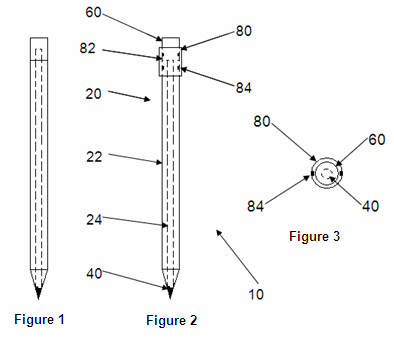Template Patent Document
You can use this patent template to write and file your own provisional patent application and get a Patent Pending Number through GlobalIPCo for $49 or through Iptica for only $99. Whereas, complete patents (which you may decide to file in a year’s time) must be prepared by a patent attorney, inventors may prepare their own provisional patent.
This template patent document will help you write a provisional patent and get a Patent Pending Number. Also see our DIY provisional patent filing guide.
Download Word .doc version of the patent template.
The only rule for a provisional patent is that it must “fully describe” the invention. You may write the document however you wish. Some inventors choose to copy the format of a complete patent, but we don’t recommend this. Rather follow this patent template:
Part 1: Drawing, sketch or photo
Illustrate your product (using drawings, sketches or photos), and associate a reference numeral with each part, e.g.:

Part 2: Parts list
“Name each part, e.g.:
10 – Pencil
22 – Body
24 – Writing element
60 – Eraser
82 – Collar”
Part 3: Part description
Describe each part individually, e.g.:
“The body 22 is: elongate; made of wood; circular, octagonal or hexagonal in axial cross-section; and defines an axially extending bore.
The writing element 24 is cylindrical and made of graphite. The outer diameter of the writing element 24 corresponds to the diameter of the bore defined by the body 22, and the axial length of the writing element 24 is at least equal to the axial length of body 22.
The collar 82 is: cylindrical, defining an axially extending bore; and is made of steel. The inner diameter of the collar 82 corresponds substantially to the outer diameter of the body 22.
The eraser 60 is a solid elastomeric body that is cylindrical in shape. The outer diameter of the eraser 60 corresponds substantially to the inner diameter of the collar 82.”
Part 4: Assembly
Describe how the parts are assembled, e.g.:
“The writing element 24 is disposed within the bore defined by the body 22, and secured therein either by an adhesive or a friction fit.
A first axial end of the body 22 is partly received axially within the bore defined by the collar 82, and the collar is crimped to secure the collar 82 to the body 22. Similarly, the eraser 60 is partly received axially within the bore defined by the collar 82, and the collar is crimped to the eraser 60 to secure the collar 82 to the eraser 60.”
Part 5: In use
Describe the invention “in use”, e.g.:
“In use:
- the second axial end of the body 22 is shaved into a conical shape, thereby to cause the writing element 24 to protrude from the body 22; and
- the exposed portion of the writing element 24 is used to write on paper. Should the user wish to erase a pencil marking, the pencil 10 is rotated and the eraser 60 is rubbed against the marking.”
That’s it. The document is done!
Common mistakes
Don’t focus too much on:
- The absence of a feature (e.g. a vehicle “without” a spare tyre).
- Use of an obvious alternative material (e.g. making a spanner out of plastic).
- An obvious combination of known features (e.g. a box containing a Phillips screw driver and a no. 11 spanner).
- An obvious alternative power source (e.g. a solar powered electric toothbrush).
- A mere benefit (e.g. a “more rugged” cellphone) – rather focus on features you have added to make it more rugged.
- A new use for an existing thing (e.g. use of a Schweppes bottle as an oil container).
- A new shape, brand / logo, or artwork – this should be protected by registered designs, trademarks and copyright, respectively.
File your provisional patent application
Next, complete the application forms and file the application.
The simplest is to file your provisional patent application through the GlobalIPCo online provisional patent filing system. Iptica offers a good alternative provisional patent filing system. Generally, it does not matter where you live (e.g. UK, Australia, Canada, New Zealand, South Africa); you should be able to file your provisional patent application through the GlobalIPCo system for only $49. If not, the system will notify you when you complete the applicant / inventor country field. Within a day of filing the provisional patent application through the GlobalIPCo system, you will receive a Patent Pending Number that may be used worldwide.

What next?
Provisional patents give you the legal right:
- publicly to disclose / sell / use your invention / product without impacting your right to patent it;
- to mark your product / service “Patent Pending” worldwide; and
- to file corresponding complete patents in the following 177 countries during the next 12 months.
Recognise that provisional patents have three main purposes:
- DETERRENCE – marking your product “Patent Pending” keeps competitors guessing what you may patent, discouraging the temptation to copy;
- MARKETING – marking your product “Patent Pending” communicates to the market that your product is “new” and “innovative”; and
- PROTECTION – it will take at least 33-63 months to obtain “enforceable protection”. Although protection has traditionally been seen as the “primary reason” for filing a provisional patent, in reality, this benefit is a lagging third to marketing and deterrence.
Note: The fact that you’ve filed a provisional patent for your new product does not necessarily mean that you may make and sell your product. If someone else has previously secured patent or design rights over the product, nothing you do can affect these prior rights – your patent application is aimed at preventing others (including any existing patent holder) from adding your “new feature” to their product.
In 12 months’ time, you will need to decide whether to:
- let your patent lapse – in which case you don’t need to do anything further;
- refile your provisional patent application, which may only be done after the 12 month period, and will erase your earlier filing date. This option is only available where: (i) your invention remains secret at the time of re-filing;
- file a new provisional patent application covering a further new feature you will shortly be adding to your product; or
- engage a patent attorney to draft and file corresponding complete patent applications in countries where you intend to secure enforceable patent rights. This is where patenting starts getting expensive.
